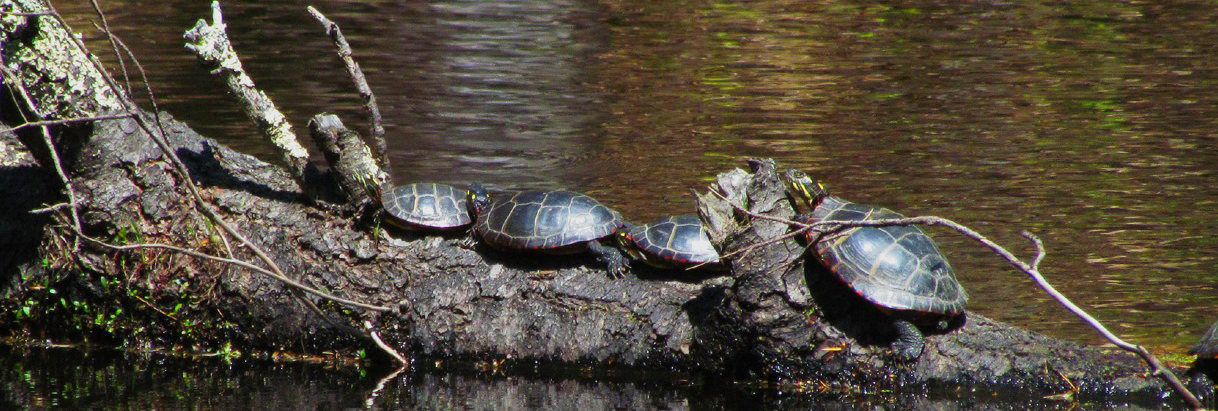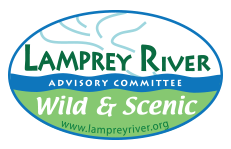B. NATURAL HISTORY (AND EFFECTS ON HUMAN HISTORY)
Wildlife Studies:
The Lamprey River corridor provides rich wildlife habitat. The Lamprey River Resource Assessment (bound report available from Sharon Meeker, 659-5441), as well as reports by two naturalists who studied Lamprey wildlife, David Carroll and George Gavutis (see "Resources"), are good places to start a wildlife study. Another is to start by taking a nature walk (with or without a local naturalist such as Kitty Miller from Lee) and see how many species or wildlife signs (tracks, scat, browse marks, bird calls, nests, burrows, etc.) students can observe. The Lamprey contains every sport fish found in New England’s stream and rivers and is New Hampshire's most significant river for anadromous fish (sea dwelling, freshwater spawning: shad, river herring, Atlantic salmon, smelt, sea lampreys). Bird watchers have inventoried 159 species of birds in Durham, Newmarket, Lee, and Epping, including four state-endangered species. Mammals thrive on the riverbanks. All six turtles species native to New Hampshire are found along the river. Rare mussels have historically had strong populations, but flood-related burial seems to have greatly reduced their numbers.
Students interested in a wildlife project might choose a species with an interesting life cycle such as the anadromous sea lamprey or the catadromous American eel. American eels have jaws and teeth, live in fresh water and spawn in the ocean--the opposite of lampreys. Eels from Europe and America migrate to the Sargasso Sea near Bermuda to spawn and their young elvers return to the parents' original streams. Sea lampreys have jawless mouths lined with rows of teeth. They are parasitic on large fish. They spawn in streams, have a larval stage in streambeds, and then live their adult lives in the ocean (or in the Great Lakes where they are landlocked). For information on lampreys, students can visit http://www.fws.gov/GOMCP/pdfs/lampreyreport.pdf or contact Stacia Sower at the University of New Hampshire. The Epilogue of Literature and the Land by Emma Rous includes a first person account about a group of boys killing eels in the Lamprey. Students can discuss how we form our attitudes toward different species--why some animals are cute and others are repulsive. Why do we protect some life forms and destroy others? How should we change?
Students can examine how the presence of dams has affected anadromous species in the Lamprey. A fish ladder was constructed at the Wiswall Dam in Durham in 2011. How much of the river was opened up to returning fish for spawning? Students can research the workings of a fish ladder and also the efforts of the NH Fish and Game Department to restock the Lamprey with trout and Atlantic salmon. Cheri Patterson of NH Fish and Game is a good resource for more information.
For many years, the same pair of mute swans returned to the river (from where?) just above the dam in Newmarket to mate, nest, and raise their young. In the spring, the swans often behaved very aggressively toward canoeists. One man had to be rescued from a swan that swamped his boat and sat on him. This story raises interesting questions about swans: Why did the swan behave as it did? What can students learn about swans' mating behavior and life cycle? Do the same swans still return? These swans are not native to this area and can intimidate local species. Should we encourage or discourage their presence?
Students might research the six types of fresh water mussels found in the Lamprey (http://www.lampreyriver.org/about-the-river-lrac-studies-mussel-survey) or study a rare species such as the Blanding's, wood, or spotted turtle. Notes on these species are available from the Lamprey River Advisory Committee.
carroll_spotted_turtles.jpgDavid Carroll has been observing and radio-tracking turtles in the Lamprey for several years. His writing and wonderful drawings and paintings of wildlife, including turtles, might inspire students to incorporate artwork in their wildlife projects. (See Swampwalker's Journal, Trout Reflections, The Year of the Turtle or Self Portrait with Turtles by Carroll in "Resources"). David Carroll does presentations in schools, sharing his knowledge, artwork, and sometimes a live specimen. He speaks eloquently and passionately on the loss of wildlife habitat and the need to protect what is left.
Spotted turtle hatchlings, David Carroll
Notes from a naturalist checking on turtles with radio transmitters indicate how critical river shoreline buffer zones are for river wildlife. Eric Rulison tracked two wood turtles which commonly burrowed in ground between the river and an open field that was covered by grass, berry plants, and dogwood. When a farmer cut this buffer zone, the turtles went to the other side of the Lamprey, where the male turtle was later found dead and hollowed out. The lack of teeth marks on the wood turtle's shell and the fact that it had been cleaned out led the naturalists to conclude that a fisher cat had eaten it. Rulison writes, "It is unfortunate that much of the buffer zone was cut. It seems apparent to me that the turtles then left the area, making them sensitive to disturbances." The male turtle was 17 years old, within a few years of breeding age, and could have lived and bred for another thirty years; therefore its loss was serious for this small turtle colony.
Students can enter a discussion about the need for habitat protection versus the rights of landowners. What do they recommend to resolve these often conflicting interests? The Lamprey River Advisory Council has developed a brochure for river landowners on managing land for the protection of wildlife habitat and water quality. (Contact info@lampreyriver.org to request a copy.) Students can review town buffer regulations and the Shoreland Water Quality Protection Act, http://des.nh.gov/organization/divisions/water/wetlands/cspa/categories/overview.htm and comments by the NH Rivers Council (http://www.nhrivers.org/) for more information about buffers.
The interdependence, or ecology, of species along the river can be a special focus for student researchers. For example, David Carroll emphasizes the importance of beaver dams to create and maintain wetland habitats for fish, turtles, and amphibians. Trees felled in the river by beavers create hiding places for fish. In another example of interdependence, certain fish carry wedge mussel larvae, an endangered species, upstream to colonize new areas.
The following excerpt from another naturalist's field notes can be shared with students to illustrate what can be discovered by being alert on and along the river. Early in May 2000, George Gavutis canoed the Lamprey from Wadleigh Falls to Lee Hook Road:
“I periodically noted fresh as well as old beaver sign throughout the trip. Hemlock and oak were girdled in numerous places ...I noted raccoon, muskrat, and deer tracks in the riverbank mud...Peepers and gray tree frogs were heard periodically as were "trilling" American toads. We repeatedly flushed and chased one male wood duck and a spotted sandpiper for miles downriver until they finally swung back upstream. [Below Little River] there were at least four drake mallards ahead of me on the river now, indicating territorial bonds were already breaking down with the females spending most of their time incubating their eggs. Soon the ducklings will be hatching (hopefully) and the males who don't have re-nesting hens, whose nests were broken up, will begin to congregate in large marshes for their summer (flightless) molt. The hens with broods may end up there as well.”
Gavutis noted 48 bird species during this trip, including a broad-winged hawk, great blue herons, meadowlarks, and bobolinks. Later that day he checked several spots on shore to hear the male woodcock's mating call.
“By the time I returned to the vehicle, a male woodcock had begun "peenting" in his diurnal brushy cover, preparatory to flying to his open singing ground to perform his evening flight ritual .... [Later] I could faintly hear at least one and possibly two woodcocks peenting and doing their flight acrobatics way back in.”
Gavutis heard five woodcocks that evening. Peterson's A Field Guide to the Birds says their "low nasal “beezp” or “peent” suggests call of nighthawk. Aerial “song” starts as a chippering trill (made by wings) as the bird ascends, and bursts like warbling of bubble pipe at climax." This display can be heard and seen at dusk or on moonlit nights in spring.
Students and teachers should take their own trips and field notes--who knows what wonders you will discover! Take field guides with you. Tum the trip into a scavenger hunt. Show students some natural “events," then have them locate (but not collect) more.

